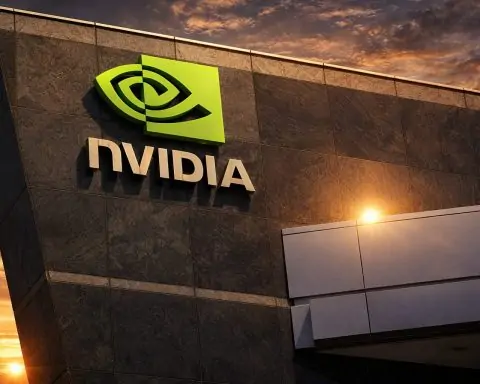NEW YORK — Thursday, November 6, 2025. U.S. stocks fell sharply in late‑morning trading, with the Dow Jones Industrial Average down more than 400 points (≈0.9%) as renewed selling in mega‑cap tech weighed on the broader market. The Nasdaq led losses at nearly 2%, while the S&P 500 was lower by a little over 1%. Concerns over stretched AI‑linked valuations, a spike in announced layoffs, and mounting disruption from the federal shutdown kept risk appetite in check. [1]
What’s moving markets
- Tech under pressure—again. After a brief respite midweek, selling returned to high‑valuation technology names and pushed indexes toward two‑week lows. Apple, Microsoft and Nvidia declined, dragging the information‑technology sector lower. [2]
- Layoffs surge to a two‑decade October high. Outplacement firm Challenger, Gray & Christmas reported 153,074 announced job cuts in October—the worst October since the early 2000s—fueling worries about a cooling labor market and stoking rate‑cut bets in bonds. [3]
- Shutdown fallout hits travel. The FAA said it will reduce air traffic by 10% across 40 high‑volume markets starting Friday to maintain safety during the prolonged government shutdown—an unprecedented step that complicates the holiday travel runway and adds a fresh macro headwind. [4]
- Bonds rally on weak labor signals. Treasury yields slipped as investors leaned into the prospect that the Fed may need to ease sooner if hiring cools further; the 10‑year yield fell intraday while equities slumped. [5]
Dow Jones today: by the numbers (intraday)
- Dow Jones Industrial Average: down ~400–425 points (≈0.9%).
- S&P 500: down ≈1%.
- Nasdaq Composite: down ≈1.7%–2.0%.
Market internals skewed negative with decliners outpacing advancers as the tech sell‑off re‑accelerated. [6]
Biggest drags on the Dow
Salesforce (CRM) and Amazon (AMZN) were the largest point‑weightings on the price‑weighted Dow early today; Salesforce fell about 6.5% and Amazon about 2.4%, together shaving roughly 137 points from the index. Losses in Microsoft and Visa added to the pressure. [7]
Earnings movers to watch
- DoorDash (DASH): Shares plunged 10–15% after the company missed profit expectations and outlined heavier 2026 investment, unnerving investors despite solid revenue growth. [8]
- Datadog (DDOG): Stock surged about 20–21% after a strong top‑ and bottom‑line beat and upbeat guidance highlighted resilient enterprise demand. [9]
- Qualcomm (QCOM): Posted a stronger‑than‑expected fiscal Q4 and solid outlook; shares fluctuated as investors weighed tax impacts and recent gains. [10]
The shutdown is distorting the data picture
With federal statistics delayed, investors are leaning on private reports and corporate guidance to triangulate the economy. The jump in planned job cuts, coupled with reduced flight capacity at major airports, is amplifying uncertainty around growth and consumer activity heading into the peak holiday period. [11]
Sector snapshot
- Technology: Led declines as AI‑exposed names retreated. [12]
- Consumer Discretionary: Mixed—DoorDash weakness hit sentiment even as select travel names faced new shutdown‑related risks. [13]
- Communication Services & Financials: Traded lower alongside the broader tape as yields fell and defensiveness crept in. [14]
The bigger picture
Thursday’s drop follows a choppy week dominated by valuation debates around AI leaders and a record‑long shutdown that is increasingly bleeding into real‑economy logistics. Volatility firmed (the VIX briefly approached the 20 area) and rate‑cut probabilities for December ticked up as bonds rallied on the bleak layoff print. For equities, that mix—weaker labor, lower yields, and less clarity on official data—has so far meant “bad news” is bad news again. [15]
What’s next
- Data & policy: With key government releases postponed, markets will parse corporate commentary and any stop‑gap private indicators for clues on demand, labor, and pricing. [16]
- Earnings: Another heavy slate of tech and consumer names is due; guidance color on holiday demand, hiring, and capex will be in focus. [17]
- Shutdown watch: Any movement toward a funding resolution—or further operational curbs like the FAA order—could swing travel, airlines, and consumer sentiment quickly. [18]
Bottom line
“Dow Jones today” is about valuation nerves colliding with fresh macro frictions. A tech‑led slump, record October layoff announcements, and a historic shutdown that’s now curbing air traffic created a trifecta of headwinds on Nov. 6, 2025. Unless policy clarity and cleaner data emerge, volatility is likely to stay elevated and leadership narrow as investors pick through earnings name by name. [19]
All index moves referenced are intraday as of late morning U.S. Eastern time on Nov. 6, 2025. [20]
Sources: Reuters, The Wall Street Journal, MarketWatch, Bloomberg, Associated Press, Challenger, Gray & Christmas. [21]
References
1. www.marketwatch.com, 2. www.reuters.com, 3. www.challengergray.com, 4. www.reuters.com, 5. www.bloomberg.com, 6. www.marketwatch.com, 7. www.marketwatch.com, 8. www.reuters.com, 9. www.barrons.com, 10. www.reuters.com, 11. www.challengergray.com, 12. www.reuters.com, 13. www.reuters.com, 14. www.bloomberg.com, 15. www.bloomberg.com, 16. apnews.com, 17. www.wsj.com, 18. www.reuters.com, 19. www.reuters.com, 20. www.marketwatch.com, 21. www.reuters.com









